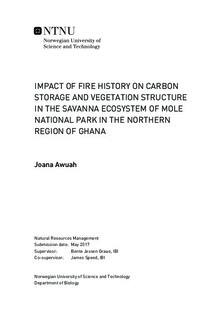IMPACT OF FIRE HISTORY ON CARBON STORAGE AND VEGETATION STRUCTURE IN THE SAVANNA ECOSYSTEM OF MOLE NATIONAL PARK IN THE NORTHERN REGION OF GHANA
Master thesis
Permanent lenke
http://hdl.handle.net/11250/2446947Utgivelsesdato
2017Metadata
Vis full innførselSamlinger
- Institutt for biologi [2573]
Sammendrag
As a management tool to balance the existence of trees and herbaceous vegetation, many protected areas in savannas are undergoing a trend of burning. Management to reduce late dry season fires and focus on low intensity fires that usually occurs in early part of the dry season could substantially help increase aboveground and belowground carbon stocks and maintain the savanna vegetation structure. This study investigated the impact of fire history on vegetation structure and carbon stocks in the 4,800km2 Mole National Park, Ghana. Based on satellite imagery data obtained from NASA s Moderate Resolution Imaging Spectroradiometer and interviews of local people and park officials, burnt and unburnt areas in the park were identified. The area was classified into 28 study sites belonging to four fire histories based on time since last burn (2000-2016) and seasonality of burning (e. g. early and late dry season burning). Data was collected in late June and early July, 2016. The woody vegetation biomass was greatest in unburnt plots and lower in other fire histories, while herbaceous vegetation biomass was the highest in burnt areas and lowest in unburnt areas. Total ecosystem carbon stocks in unburnt area were significantly higher than recent late season burn sites and old late season burn sites but not recent early season burn sites. Belowground (0-17cm depth soil) carbon stocks contained in unburnt study sites was greater than carbon stocks in recent late season burn areas though the difference was only significant at depth 12-17cm. Study areas that were burnt later in the dry season contained less carbon stocks than areas burnt early in the dry season. In conclusion, late dry season fires reduce vegetation structure, ecosystem carbon stocks and biomass, although soil carbon stocks seem to recover within four years. It is therefore suggested that, for effective management of the savanna ecosystem, early dry season fires with low intensity should be encouraged to prevent late dry season fire.
